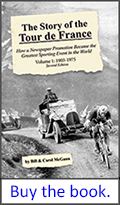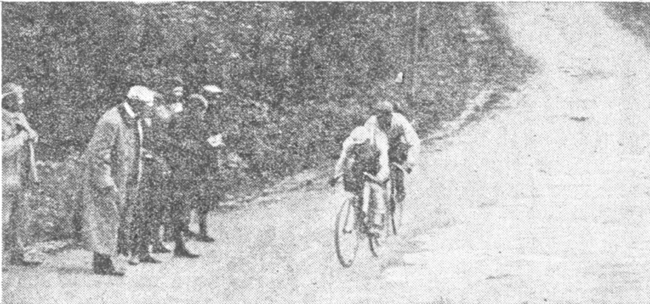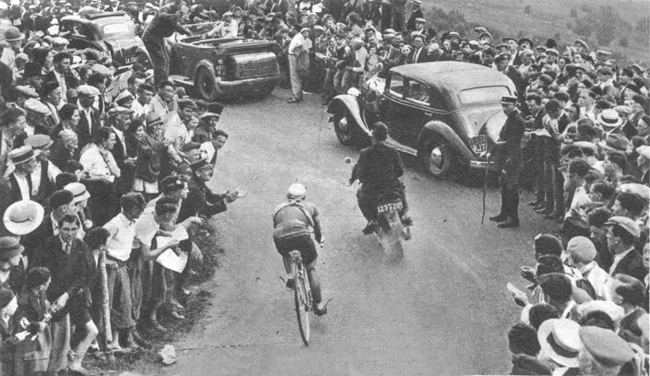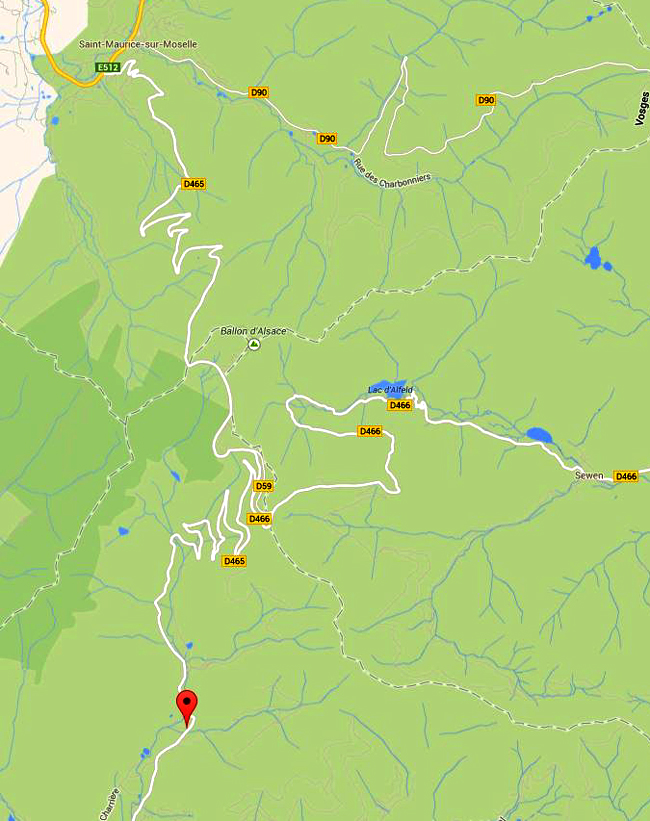Col du Ballon d'Alsace
(Elsässer Belchen in German)
Its cycling history, photos, statistics, and map
Statistics | History | Photos | Map |
Back to KOM French climbs | Back to KOM index page

The Col du Ballon d'Alsace is a pass in the Vosges which are low mountains near France's border with Germany. It great fame in cycling comes from the 1905 Tour de France when it became the Tour's first serious climb. It sits almost on the border between the Haut-Rhin and Vosges departments.
Col du Ballon d'Alsace statistics:
The ascent used in the 1905 and other early editions of the Tour de France climbed from the north, starting from Saint-Maurice-sur-Moselle:
Average gradient: 6.9%
Maximum gradient: 8.0%
Length of climb: 9 km
Elevation at start: 552 meters
Elevation at crest: 1,178 meters
Elevation gain: 619 meters
Climbing from the south, starting from Malvaux:
Average gradient: 5.2%
Maximum gradient: 7.2%
Length of climb: 12.4 km
Elevation at start: 535 meters
Elevation at crest: 1,178 meters
Elevation gain: 643 meters
Climbing from the east, starting in Sewen:
Average gradient: 5.1%
Maximum gradient: 8.7%
Length of climb: 13.2 km
Elevation at start: 500 meters
Elevation at crest: 1,178 meters
Elevation gain: 678 meters
Col du Ballon d'Alsace history in the Tour de France:
The first two editions of the Tour de France (1903 and 1904) had ascended the Col de la République but hooligans attacked riders during the climb's 1904 ascent. While partisans of their local riders were making the Loire department distasteful to Tour management (the Tour wouldn't return to the area until 1950), Alphonse Steinès was pressuring Tour de France boss Henri Desgrange to include more difficult climbs.
Desgrange, fearing more difficult ascents would be beyond the riders' ability, initially resisted. However Steinès prevailed and the second stage of the 1905 Tour de France went up the Col du Ballon d'Alsace. Though the crest is only slightly higher than the Col de la République, it is a much steeper climb. René Pottier was first over the summit, though Hippolyte Aucouturier won the stage.
Thereafter the ascent was used in every edition until the Great War. It wasn't included again until the 1930s (1930, 1933, 1934, 1935, 1936, 1937). Since the Second World War the Ballon d'Alsace has been used only rarely (five times as of 2014).
Col du Ballon d'Alsace photos:

Henri Desgrange watches riders ascend the Ballon d'Alsace during the 1906 Tour de France.
 |
Hippolyte Aucouturier changes a front wheel on the Ballon d'Alsace in the 1906 Tour. Note the tubular tire tied under his seat and the single front brake. |

Octave Lapize on the Ballon d'Alsace in the 1911 Tour de France.

1935 Tour de France, stage 4: Leo Amberg climbs the Ballon d'Alsace.

1936 Tour de France, stage 4: Federico Ezquerra is on his way to being the first over the summit, but Maurice Archambaud would win the stage.

Ballon d'Alsace map. Malvaux, from where the climb from the south is scored is the red dot. The approach from the east starts in Sewen on the D466 in the right-side middle of the map. The historic climb from the north starts in Saint-Maurice-sur-Moselle near the map's top.









